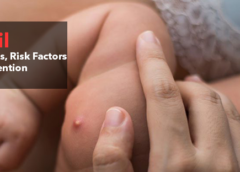Overview
A boil is a painful, pus-filled lump that forms under your skin when bacteria invade one or more of your hair follicles and inflame them. A carbuncle is a cluster of boils that form a related infection area underneath the skin.
Boils (furuncles) usually begin as red, tender bumps. The bumps fill up with pus easily, becoming bigger and more painful until they burst and drain. The most likely places to be affected are the nose, neck back, armpits, thighs and buttocks.
Symptoms of Boils
A boil usually starts out about half an inch in size as a hard, red, painful lump. The lump grows larger, softer and more painful over the next few days. Quickly a pocket of pus makes on up of boil. These are the symptoms of a severe infection:
- The skin around the boil becomes infected. It turns red, painful, warm, and swollen.
- More boils can appear around the original one.
- A fever may develop.
- Lymph nodes may become swollen.
When to see a doctor
When after a few days a boil on the buttocks doesn’t improve with warm compresses, visiting a doctor may be helpful.
When the boil becomes more swollen or painful, if the redness spreads or if a fever occurs, a person should see their doctor earlier.
Boils can in some cases lead to a deeper infection known as an abscess. This will also need to be drained and may require other treatments done by a specialist.
For individuals with immune system problems, these infections can be particularly serious.
Causes of Boils
A germ (staphylococcal bacteria) is responsible for the most boils. This germ enters the body through tiny nicks or cuttings in the skin or can travel to the follicle down the hair.
Such health conditions increase people’s vulnerability to skin infections:
- Diabetes
- Problems with the immune system
- Poor nutrition
- Poor hygiene
- Exposure to harsh chemical substances which irritate the skin
Risk Factors
Although everyone may grow boils or carbuncles — even otherwise healthy people — can increase the risk by the following factors:
Close contact with staph infected human: If you stay with someone who has a boil or a carbuncle, you’re more likely to develop an infection.
Diabetes: The disease will make it harder for your body to combat infection like your skin’s bacterial infections.
Other Skin Conditions: Because they weaken the protective layer in your skin, skin problems like acne and eczema make you more susceptible to boils and carbuncles.
Compromised Immunity: When, for whatever cause, the immune system gets compromised, you are more vulnerable to boils and carbuncles.
Complications
Rarely, bacteria will enter your bloodstream from a boil or carbuncle, and migrate to other parts of your body. The spreading infection, generally referred to as blood poisoning (sepsis), may lead to deep body infections, such as the heart (endocarditis) and bone (osteomyelitis).
Although most boils do not cause any problems, but not always the case.
Scarring
After a larger boil or carbuncle, scarring may often occur. Such scars never completely disappear but they fade over time and become less visible.
If you are especially worried about wounds, there are many treatment options, including:
- Plastic surgery
- Injections of corticosteroids which can help to flatten a raised scar
- Pressure pads that can help to flatten and soften a scar
It’s doubtful, though, that your local clinical commissioning group (CCG) will fund such services unless your injuries can be proven to cause you significant psychological distress.
Make-up is a simpler alternative to conceal any scars you have. Camouflage make-up is available at counter at pharmacies especially designed to cover scars.
Spread of infection
Sometimes the bacteria inside a boil or carbuncle may spread to other parts of the body and cause a secondary infection.
The secondary infection associated with boils and carbuncles is cellulitis. The deeper layers of the skin are infected with it.
Less common secondary infections involving boils and carbuncles are:
- Impetigo – a highly contagious skin infection that causes sores and blisters
- Septic arthritis – an infection of a joint
- Osteomyelitis-an infection inside the bone
- Endocarditis-an infection of the heart’s inner layer
- Septicaemia – an infection of the blood
- Brain abscess – a set of pus formed inside the brain
Many of these less common secondary infections must be treated with antibiotic injections. Admission to an Intensive Care Unit (ICU) may be needed in case of septicaemia and brain abscess.
Prevention
Boils can’t always be stopped, particularly if you have a weak immune system. But the following measures may help you avoid staph infections:
Wash your hands regularly with mild soap: Or use an alcohol-based hand rub often. Careful hand-washing is your best defense against germs.
Keep wounds covered: Clean and cover the cuts and abrasions with clean, dry bandages until they heal.
Avoid sharing personal items: Do not share towels, sheets, razors, shoes, sports equipment and other personal belongings. Staph infections can spread through items, and from one person to another. Wash your towels and linens using detergent and hot water with added bleach, if you have a cut or sore, and dry them in a hot dryer.

Leave a Reply
You must be logged in to post a comment.